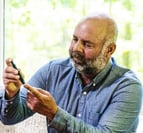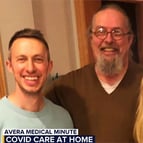As a healthcare practitioner who’s getting started with telehealth and remote patient monitoring (RPM), you understand that the key to success lies in having a systematic approach to every component of the program. Typically, the components of RPM services that your team would provide include the initial equipment setup and installation, virtual visits as needed, and condition monitoring based on biometric data and information collected in real time.
Within the telehealth platform, patients can directly access RPM services like educational videos, teach-back quizzes, and medication reminders on their own. These features help improve patient engagement as patients can play an active part in their health.
Additionally, caregivers benefit from being incorporated into the program as they gain valuable insight into the patient’s care plan. This visibility enhances the role of the caregiver, while alleviating the physical and mental strain that may arise from the care experience.
These three main groups—practitioners, patients, and caregivers—interact with and use RPM services differently. In this blog, we’ll explore real examples of how these groups communicate throughout the care process and what can be considered as improved outcomes from the patient and caregiver perspective.
Installation Services: Setup for Success in 6 Steps
Laying the foundation for a successful telehealth and RPM program begins with the equipment installation. It’s crucial to instill confidence and build trust at this early stage as this ensures active participation and engagement from patients and caregivers.
Step 1: Prepare before the installation visit
Create a checklist of to-dos before the visit, like making sure all devices are charged and reviewing patient notes.
Tip for success: Enlisting a dedicated, non-clinical personnel to manage this step can help ease workload requirements and processes. HRS offers virtual installations with a team of Engagement Specialists through our PatientDirect+ service.
Step 2: Engage family caregivers
Include the caregiver in the process so they’re aware of how the platform works.
Tip for success: Encouraging caregivers to participate makes the patient feel supported and strengthens the network of stakeholders committed to the patient’s success.
Step 3: Explain telehealth and its benefits
Adopt a friendly and conversational tone when explaining the technology and encourage questions.
Tip for success: Put the patient’s worries to rest by reassuring them that there is no “wrong way” to engage with the platform, especially if digital literacy is a concern.
Step 4: Offer educational resources
Take the time to walk the patient through important resources related to discharge instructions and the telehealth program.
Tip for success: At HRS, we recommend sharing a Welcome Letter with patients during the installation visit that outlines the benefits of telehealth, reviews their daily routine while using telehealth, and includes key contact information should they need it.
Step 5: Practice, practice, practice
Apply teach-back methods to get the patient to demonstrate that they understand what’s been explained to them.
Tip for success: Perform a practice virtual visit so the patient feels more comfortable and familiar with the platform before participating in an actual virtual visit.
Step 6: Follow up and provide reassurance
Call the patient a day after the installation to provide encouragement and support, as well as answer any questions they may have thought of following the visit.
Tip for success: Focus on building the patient’s confidence and remind them that all the resources they need are easily accessible within the platform.
Remote Patient Monitoring Services: What Success Looks Like for Patients and Caregivers
Once the patient is up and running on the telehealth platform, success can be measured by how effectively they engage with the RPM services available, and what outcomes were achieved as a result. Here are examples of success stories from patients who have used telehealth and RPM to manage various health conditions.
Congestive Heart Failure (CHF)

Alice
- The situation: Through the telehealth and RPM platform, Alice’s nurse noticed that she gained three pounds in 24 hours and her oxygen saturation decreased. The nurse immediately scheduled a skilled nursing visit—they found abnormal lung sounds and coordinated with Alice’s care team to update her medication regimen.
- The outcome: After several days, Alice’s weight and breathing returned to normal. The nursing team was able to treat Alice in her home and prevent an emotional and costly trip to the emergency room.
- Meet Alice

Mr. K
- The situation: Mr. K has multiple chronic conditions and when he was readmitted to the hospital and diagnosed with CHF and chronic kidney disease, he had gained 75 pounds. To cope with his symptoms and prepare him to live independently in the future, Mr. K enrolled in the telehealth program, gaining access to features like advanced symptom monitoring, educational videos, and quizzes.
- The outcome: In the months following his participation in the program, Mr. K has not been readmitted to the hospital and has lost 25 pounds thanks to dietary changes, education from his nurses, and vital signs monitoring.
- Meet Mr. K
COVID-19

Kevin
- The situation: Kevin is at high risk of adverse outcomes if diagnosed with COVID-19 due to his pre-existing conditions. When his test came back positive, his care team immediately took action to transition him to at-home care. Within hours, Kevin was back at home with an HRS monitoring kit that he used to log his vitals and symptoms twice a day.
- The outcome: The care team monitored Kevin’s health continuously throughout his recovery, providing encouragement and support until his symptoms abated and he was no longer at risk of being hospitalized.
- Meet Kevin
Hospice

Francis
- The situation: Francis was recently enrolled in an inpatient hospice program to provide him with 24/7 pain management. Shortly after, the pandemic spread across the country and Francis’ facility was forced to temporarily halt patient and family visits. As an alternative, the hospice provider partnered with a telehealth and RPM provider to help their patients stay connected with their caregivers.
- The outcome: Using an HRS kit, provided by his hospice care team, Francis can video conference with his daughter every day, helping to keep his spirits high. For Francis’ daughter Pam, she can see her father is staying safe, happy, and comfortable and can connect with his hospice care team with the push of a button.
Need Help Getting Started with Your Telehealth Program?
With any telehealth and remote patient monitoring implementation, there will be changes to how your team operates and delivers care. However, setting up a clear and methodological process from the start will help your organization handle the change and keep the momentum going. Learn more with a free demo from our team!
